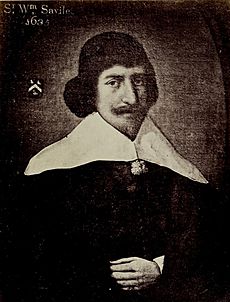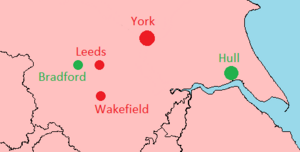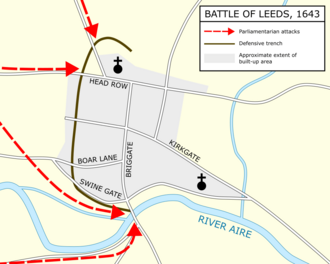Battle of Leeds facts for kids
Quick facts for kids Battle of Leeds |
|||||||
|---|---|---|---|---|---|---|---|
| Part of the First English Civil War | |||||||
|
|||||||
| Belligerents | |||||||
| Commanders and leaders | |||||||
| Sir William Savile | Sir Thomas Fairfax | ||||||
| Strength | |||||||
| c. 2,000 | c. 3,000 | ||||||
| Casualties and losses | |||||||
| 40–50 killed 460 captured 2 cannons captured |
c. 20 killed | ||||||
The Battle of Leeds happened during the First English Civil War on January 23, 1643. It was a fight between the Parliamentarian army and the Royalist soldiers holding the town of Leeds, Yorkshire.
The Parliamentarians attacked partly to keep people in the area supporting them. The Earl of Newcastle had recently made the Royalists much stronger in Yorkshire. He brought an army of 8,000 men. One of his commanders, Sir William Savile, was sent to capture Leeds.
The West Riding of Yorkshire region depended on making cloth. So, Ferdinando, Lord Fairfax sent his son, Sir Thomas Fairfax, to help protect nearby Bradford. Sir Thomas then asked to attack Leeds, and his father agreed.
Sir William Savile had about 2,000 men in Leeds. He built a trench on the west side of town. He also destroyed one bridge and made another very strong. Sir Thomas Fairfax attacked during a heavy snowstorm. He led about 3,000 men to attack Leeds from three different directions. The battle lasted about two hours. The Parliamentarians won the town and captured around 500 prisoners. Fairfax lost about 20 men, while the Royalists lost about twice as many.
Contents
Why the Battle Happened
In January 1643, the First English Civil War had been going on for five months. It started when King Charles I declared Parliament's leader, the Earl of Essex, a traitor. This war was caused by many disagreements over religion, money, and laws that had built up for years.
The War in Yorkshire
When the war officially began in August, King Charles put the Earl of Cumberland in charge of the Royalist forces in Yorkshire. But Cumberland wasn't a strong military leader. His forces were also too small. Because of this, the Royalists lost several battles in the county.
The Earl of Newcastle was asked to help. Cumberland then gave him command of the forces. Newcastle marched into Yorkshire with about 8,000 men. He beat the Parliamentarians at Piercebridge. He then set up his base in York on December 3.
Among Newcastle's men was Sir William Savile. Savile was sent to take control of the West Riding towns. These included Leeds, Wakefield, and Bradford. Savile had already gathered 900 men from the area. With 1,500 foot soldiers and 500 horsemen, he took Leeds and Wakefield easily. But he had to send some of his men to try and capture Bradford on December 18. They were pushed back there.
Newcastle's arrival in Yorkshire changed everything. Before this, the Parliamentarians, led by Ferdinando, Lord Fairfax, had been stronger. But with 8,000 new Royalist soldiers, the Parliamentarians were greatly outnumbered. They couldn't properly defend the important cloth-making areas. Lord Fairfax worried that people would stop supporting Parliament. So, he sent his son, Sir Thomas Fairfax, to help Bradford. Sir Thomas arrived in late December with 120 dragoons (soldiers who rode horses but fought on foot) and three groups of cavalry.
Leeds Town's Importance
The small wool town of Leeds was in the West Riding of Yorkshire. Today, it's part of West Yorkshire. Leeds was important for both its economy and its location during the war. The cloth industry was vital for the area. The final steps of making cloth happened in Leeds.
Also, Leeds was on the main roads to York, Chester, and Hull. This meant it controlled access to food grown in the Vale of York. At that time, Leeds was mostly built around one main street, Briggate. This street ran down to the River Aire. Other streets like Kirkgate and Boar Lane branched off Briggate. About 6,000 people lived in Leeds.
Unlike towns such as Hull, Leeds did not have strong walls. It had very few natural defenses. Sir William Savile prepared the town for defense. He had a trench dug that was about 6 feet (1.8 meters) deep. This trench went from St John's Church on Upper Head Row down to the river. He also built strong defenses near the bridge over the river. He placed cannons called demi-culverins to cover Briggate. These cannons fired heavy shots. The entrances to the town along Briggate and Head Row were blocked with barricades. Defensive positions were set up nearby.
Preparing for Battle
Sir Thomas Fairfax armed as many people in Bradford as he could. By the second week of January, he believed he had about 3,600 men. This was a big increase for the Parliamentarians. He wrote to his father, saying that people were getting impatient. They wanted the Royalists out of Leeds and Wakefield. He explained that these towns were key to Bradford's economy. He wanted to take them back.
Lord Fairfax agreed and sent more soldiers to help with the attack. Historians say this was a risky plan. He was dividing his forces even though the Royalists outnumbered him. He was also letting public opinion guide his strategy. Another historian, Stanley D.M. Carpenter, thought Lord Fairfax knew he couldn't win big battles. He also couldn't hold large areas. So, he decided to use a Fabian strategy. This meant attacking the Royalists where they were weakest. This would stop Newcastle from settling in.
Sir Thomas Fairfax gathered over 3,000 men. This included 800 to 1,000 musketeers (soldiers with muskets). There were also 400 to 500 mounted troops (cavalry and dragoons). About 2,000 were clubmen. Fairfax didn't mention the clubmen in his own report. One historian, David Cooke, thinks this was because Fairfax didn't think they were good fighters. The clubmen were mostly men from Halifax and Bradford. They had been armed only a few days before and had no battle experience.
On Monday, January 23, Fairfax led his force to attack Leeds. Three officers shared command. Sir Henry Foulis led the mounted troops. William Fairfax (Thomas's cousin) led the foot soldiers, including the clubmen. A smaller group went with Captain Mildmay. This group had one company of dragoons, about 30 musketeers, and half of the clubmen.
Fairfax ordered Mildmay to go along the south side of the River Aire. His group was to gather on Hunslet Moor. They would attack Leeds from the bridge at the south end of Briggate. They would also stop any messages from being sent to Royalist-held Wakefield. Fairfax planned to cross the river near Kirkstall Abbey, about 3 miles (4.8 km) northwest of Leeds. The Royalists had destroyed the bridge there. So, Fairfax's men crossed the river at Apperley Bridge, another 4 miles (6.4 km) upstream. They then gathered at Woodhouse Moor, about 1 mile (1.6 km) from Leeds.
From there, Fairfax sent a messenger to Savile. He demanded that Savile give up the town to the Parliamentarians. Savile refused. He complained that it wasn't polite to come so close before asking them to surrender. He said they would fight to defend Leeds.
The Battle Begins
In a heavy snowstorm, Fairfax began his attack on Leeds around 2 PM. He split five companies of foot soldiers. He also sent a company of dragoons who would fight on foot. Sergeant-Major Forbes led them south along the trench towards the river. They attacked near the bridge. A gunfight with muskets started with the defenders.
Fairfax sent his cousin, William Fairfax, and Sir Thomas Norcliffe with some musketeers. They attacked the town from the north, near the church. Fairfax himself attacked the western end of Head Row. Mildmay's group reached the river. They forced the Royalists away from the south end of the bridge. Because of this, Savile ordered one of his cannons moved down Briggate to fire at Mildmay's men.
Some of Forbes's dragoons fired so much at one of the defensive sconces (small forts) that the Royalists left it. Forbes led some of his men into the fort. Soon after, the other sconce was also left empty. Forbes and Mildmay were then able to join their forces.
This combined group fought their way north along Briggate. They drove Royalist soldiers out of each house as they went. Schofield, a minister from a chapel near Halifax, was with the Parliamentarians. He led twelve musketeers up the street towards the second cannon. They managed to kill the crew and capture the gun. Both Thomas and William Fairfax's attacks had also broken through the barricades. By around 4 PM, all three forces met at the Market Place at the end of Briggate.
Savile, one of his captains, and the town's vicar tried to escape. They swam the River Aire on their horses. Savile and the vicar made it across, but Captain Beaumont drowned. Fairfax captured 460 Royalist soldiers. He also took 14 barrels of gunpowder, two cannons, and many weapons and ammunition. The prisoners were released after they promised not to fight against Parliament again. The Royalists had between 40 and 50 soldiers killed. The Parliamentarians lost about half that number.
What Happened Next
Survivors from Leeds reached Wakefield around 6 PM. They brought news that Leeds had been captured. This made Wakefield's soldiers leave the town that night. They went to join Newcastle at Pontefract. Newcastle then decided to move his forces back to York. Parliamentarian soldiers from Almondsbury took control of Wakefield on January 24.
Parliament used the capture of Leeds as a victory. They printed leaflets celebrating the win by the "Bradford men, with their Clubs and Forks." This was common during the civil war to spread good news.
Later, in 1644, Thomas Fairfax won a huge victory at Marston Moor. After this, most of northern England was controlled by Parliament. The next year, Fairfax became the commander-in-chief of Parliament's army. He created the famous "New Model Army". This army won many battles, like Naseby and Langport. These victories helped Parliament gain control of most of England.
Images for kids







